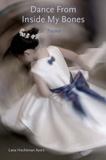December 20, 2011DANCE FROM INSIDE MY BONES
Review by Natasha Kochicheril Moni
Snake Nation Press
Valdosta, Georgia
ISBN978-0-9754843-6-4
84pp., $15.00
www.snakenationpress.org
As parceled in three sections–“Learning The Steps”, “Dancing Backwards”, and “Save The Last Dance For Me”–Dance From Inside My Bones reveals a poetic account as personal as the title alludes. Sometimes scientific as with “Worm Glow,” other times reflecting Ayers’ background in mathematics as in “Irrational Numbers”, more often than not exploring relationships as one might study a course in sociology, this 2007 National Book Award nominee dares to unravel herself on paper for the span of 47 poems, favoring the narrative.
Dance From Inside My Bones opens with “invincible airplanes roaring to and fro…/…they were invading monsters,/ pterodactyls reawakened from pre-historic days” (from “Growing Up Under Flight”), possibly alluding to the less mechanical monsters that will populate the remaining poems, those monsters of unrelenting men, attack from within and without, and the coping with grief. Ayers is not afraid to employ rhyme, but rather favors it, as in, “The film of my earliest memory–/ looking up from the carriage at Mommy” (from “Unforgettable”), or, “I’m just a girl who can’t cut parallel lines./ Sometimes, I stare all day long at gigantic pines,/ waiting for them to topple” (from “Considering”). She takes on poets such as Whitman, and throws back an allusion or two to Plath, alternating “Daddy” for “Mommy” as in the above-mentioned line from “Unforgettable” and the first two lines to “Considering”: “My mother was a suicide / who forgot to turn on the gas.”
There is humor within this first collection which spans from wit to rawness, a conflict exposed in more ways than one throughout Dance From Inside My Bones–how to unify an experience so vast in both pleasure and pain, how to share the unspeakable and leave the reader the opportunity to both access and walk away without a sense of injury. When Ayers accomplishes this it looks something like her poem “This Rose-Shaped Scar:”
serves as permanent reminder
of when my brother pushed me
…a jagged busted beer bottle
gnawed at my knee…
until he was done,
leaving the impression
I’d been bitten by a rose.
Herein, the reader may move along with the author for a one-stanza breath of trauma broken by the following poem: “Irrational Numbers” which leads the reader into a junior-high crush on the Geometry teacher. The reader is left with the intensity of the voice in “This Rose-Shaped Scar,” will not forget the development of this violence, but may choose to follow the character as with the preceding work.
As with the repeated image of scarring, Ayers revisits that which gives light or in particular, the celestial:
puff-white contrails that glowed like
spiral halos. . .
the sun shining down
on silver metal set planes aflame, transformed them
into broken-off missives of sun.(from “Growing Up Under Flight”)
Once we went as high as six hundred and one,
tracking the stars, scratching lines in bundles of fives
into the stoop using a pebble like a piece of chalk.(from “Stars”)
and gradually, the author begins to withdraw as in “II: Dancing Backwards,” where the reader may view light in subtle ways with inferences to that which shines: “the window glass,” “the ceiling fan,/ bending a cheap blade into what looked like/ a broken bone”, and “the television screen” (from “Dear John”); “rainbow trout” and “birthday candles without the cake” (from “Newly Single”); “summer constellations tip hazy halos” (from “Arrhythmia”).
Dance From Inside My Bones catalogs more explicit abuse. Two of the more powerful poems in this book fall within this section:
From “Blue Sky”:
The room tilts after
you flip the coffee table
and fly at my neck —never mistake love for violence:
passion cracks bones,
blasts china to smithereensYou could break your own teeth
clamping them down
when I repeat that other woman’s name —
And from “3 AM”:
A night-song of dry leaves clutching to branches,
as even in nature, letting go is hard. . .
Your watch ticking on the nightstand,
sounds like a mournful cricket. . .
I stroke the blood-dark skin of your chest, . . .
If only I could get enough of
your sweat to drown.
Through the process of grieving, the author brings her readers through the final section of her debut first-collection with honesty. What would it be like to release like a child and “throw a tantrum” as in “Instead of Writing This Poem,” or do the opposite and be “The Good Patient” as in “It is my job to take the pills/ and I do my job like a good girl.”
In the final section, Ayers installs a prose poem entitled “The Toe” which offers a break in form and details in particular her mother’s toe in a way that is not sentimental but rather touching and finds a way once more to draw upon Plath and music (this time country) and even reflect upon Mona Lisa.
Overall, Lana Hechtman Ayers has provided many proficient poems with attentive line breaks, carefully crafted images, and thoughtful form. Ayers risks challenging subject matter with exploration that could be considered textural, genuine, and spirited. Winner of the 2006 Violet Reed Haas Prize For Poetry, Lana Hechtman Ayers delivers poetry that engages, poetry for art and communication’s sake–there is much to be admired here.